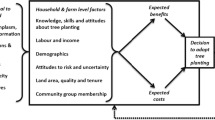Abstract
The integration of agriculture and forestry is commonly viewed as a foundation for sustainable livelihoods for small-scale farmers. In many tropical countries, traditional farming practices by smallholders include some trees or forest management for multiple purposes. This article reports on research that explores the experiences of smallholders in Central Java, Indonesia, who are increasingly blending aspects of their traditional farming practices with cultivation of commercial timber trees. Smallholders manage complex farming systems that are responding to the demands of commercial markets. Smallholders in Central Java typically manage a wide range of species that yield short-, medium- and long-term products that are used by households and sold into commercial markets. However, the authors’ research indicates that smallholders may not be optimising their forest management in relation to the potential financial returns, leading to a lower expectation of the value of forestry to their livelihoods. Support for community forestry could address several knowledge gaps amongst smallholders, so that community-based commercial forestry achieves its potential.



Similar content being viewed by others
References
Alden Wiley L (2002) From meeting needs to honouring rights: the evolution of community forestry. Invited paper submitted to the XII World Forestry Congress, Quebec
Awang SA, Wahyu A, Barriatul H, Wahyu TW, Agus A (2002) Community forestry: social economic and marketing. Publisher Agency of Economic Faculty of Gadjah Mada University, Yogyakarta
Bryman A (2008) Social research methods. Oxford University Press, Oxford
Bull G, White A (2002) Global forests in transition: challenges and opportunities. In: Proceedings of global perspective on indigenous forestry: linking communities, commerce and conservation, 4–6 June 2002, Vancouver
Cernea MM (1991) The social actors of participatory afforestation strategies. In: Cernea MM (ed) Putting People First: Sociological variables in rural development, 2nd edn. Oxford University Press, Oxford, pp 340–393
Charnley S, Poe MR (2007) Community forestry in theory and practice: where are we now? Annu Rev Anthropol 36(October):301–336
Fisher RJ (2003) Innovations, persistence and change: reflections on the state of community forestry. In: RECOFTC, FAO (eds) Community forestry: current innovations and experiences. Regional Community Forestry Training Centre (RECOFTC), Bangkok
Food and Agriculture Organisation (FAO) (2012) State of the World’s Forests: 2012. Food and Agriculture Organisation of the United Nations, Rome
Forest Watch Indonesia (FWI) and Global Forest Watch (GFW) (2002) The state of the forest: Indonesia. Forest Watch Indonesia, Bogor, Indonesia
Forestry Provincial Office of Central Java (2011) Secondary data from sub department of forest exploitation. Semarang, Indonesia
Gilmour DA, Fisher RJ (1997) Evolution in community forestry: Contesting forest resources. In: Victor M (ed) Community forestry at the cross road: reflection and future directions in the development of community forests. Regional Community Forestry Training Centre (RECOFTC), RECOFTC Report No. 16, Bangkok
Gilmour D, Malla Y, Nurse M (2004) Linkages between community forestry and poverty. Regional Community Forestry Training Centre, Bangkok
Hairiah K, Mustofa AS, Sambas S (2003) Introduction of agroforestry. Agroforestry teaching materials. Word Agroforestry Centre (ICRAF). Bogor, Indonesia
Hobley M (1996) Participatory forestry: the process of change in India and Nepal. Overseas Development Institute, London
Hobley M (2007) Forests—the poor man’s overcoat: foresters as agents of change? Paper presented at the Australian National University, 3rd April, Canberra
King N, Horrocks C (2010) Interviews in qualitative research. Sage, London
Kininmonth JA (1986) Wood from fast-grown, short-rotation trees. In: Proceedings of the 18th IUFRO word congress. Division 5: forest products, Ljubljana
Malla Y (2000) Impact of community forestry policy on rural livelihoods and food security in Nepal. Unasylva 51(202):37–45
Pagdee A, Kim Y, Daugherty PJ (2006) What makes community forest management successful: a meta-study from community forests throughout the world. Soc and Nat Resour 19(1):33–52
Penny DH, Ginting M (1984) Yard, farmers and poverty: a study of the nature and essence of Sriharjo rural farming community in Java. Gadjah Mada University Press, Agro Economics Foundation, Yogyakarta
Race D, Bisjoe AR, Hakim R, Hayati N, Julmansyah, Kadir A, Kurniawan, Kusumedi P, Nawir AA, Nurhaedah, Perbatasari DU, Purwanti R, Rohadi D, Stewart H, Sumirat B, Suwarno A (2009) Partnerships for involving small-scale landholders in commercial forestry: lessons from Australia and Indonesia. Int For Rev 11(1):87–95
Sands R (2005) Forestry in a global context. CABI Publishing, Wallingford
Sutigno P (1987) The nature and usefulness of Albizia falcataria timber. Discussion proceedings of nature and usefulness timber type of timber estate. Forestry Research and Development Agency, Jakarta, Indonesia
Wiersum KF (1988) Outline of the agroforestry concept. In: Viewpoints of agroforestry II. Department of Forestry Hinkeloord, Agricultural University of Wageningen, The Netherlands
Acknowledgments
The authors express their warm appreciation to the smallholders and district forestry staff of Central Java who kindly gave their time to discuss their experiences about community forestry. Also, the authors thank their many colleagues working on the research project ‘Overcoming Constraints to Community-Based Commercial Forestry in Indonesia’, to which the information reported in this article contributes. The research project received financial support from the Australian Centre for International Agricultural Research during 2011–2014.
The authors thank Steve Harrison and two anonymous reviewers for their constructive comments on an earlier draft of this article.
Author information
Authors and Affiliations
Corresponding author
Appendix
Rights and permissions
About this article
Cite this article
Irawanti, S., Ginoga, K.L., Prawestisuka, A. et al. Commercialising Community Forestry in Indonesia: Lessons About the Barriers and Opportunities in Central Java. Small-scale Forestry 13, 515–526 (2014). https://doi.org/10.1007/s11842-014-9268-4
Accepted:
Published:
Issue Date:
DOI: https://doi.org/10.1007/s11842-014-9268-4




